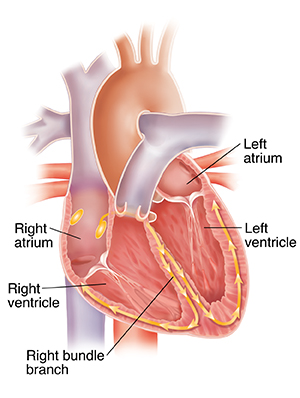Right Bundle Branch Block
Right bundle branch block is a problem in the heart’s electrical system. Your heart uses electrical signals to cause the heart muscle to squeeze and keep pumping normally. Normal heartbeats start in the upper right heart chamber. This is called the right atrium. The electrical signals are passed to the ventricles, the main heart pumping chambers. The signals travel over special fiber pathways called bundle branches.
There are two main bundle branches. One is in the right ventricle, and the other is in the left ventricle. The signals usually move at the same speed down each branch. This causes the right and left ventricles to contract at the same time. In right bundle branch block, the right bundle branch doesn't conduct electricity well. That causes a delay or a block. The left and right ventricles don't squeeze at the same time. Instead, the right ventricle squeezes just a little later.

What causes right bundle branch block?
Right bundle branch block can be caused by a number of conditions, such as:
-
Heart disease from high blood pressure
-
Chronic obstructive lung disease (COPD)
-
Blood clot in the lung (pulmonary embolism)
-
Cardiomyopathy
-
Myocarditis
-
Heart attack
-
Congenital heart disease
-
Surgery or other procedures on the heart
In some cases, the cause of right bundle branch block is not known. The heart otherwise looks normal.
What are the symptoms of right bundle branch block?
Right bundle branch block doesn't cause symptoms on its own. It may make symptoms of other heart problems worse, such as heart failure.
How is right bundle branch block diagnosed?
Right bundle branch block is diagnosed with an electrocardiogram (ECG). This test looks at the heart’s rhythm. The condition is often found during an ECG for some other reason. Your healthcare provider may want to check you for other health problems. They may ask about your health history and give you a physical exam. You may also have other tests, such as:
-
Echocardiogram, to look at your heart’s motion and blood flow through the heart
-
Testing to check the health and function of your lungs
-
Blood tests to look at your overall health
How is right bundle branch block treated?
If you have no symptoms and no other heart conditions, you don't need treatment. If you have heart disease, your healthcare provider will want to keep track of your heart health. In certain cases of severe heart failure, or other conduction disease, you may need a pacemaker. It can help restore the normal pattern of the heart.
Living with right bundle branch block
Your healthcare provider may give you more instructions about how to manage your overall heart health. You might need to make lifestyle changes, such as:
-
Losing weight
-
Quitting smoking
-
Improving your diet
Keep track of any heart symptoms you have. See your healthcare provider regularly, even if you don’t have any symptoms. Make sure all your healthcare providers know about your right bundle branch block.
When should I call my healthcare provider?
Call your healthcare provider right away if you have any of these: